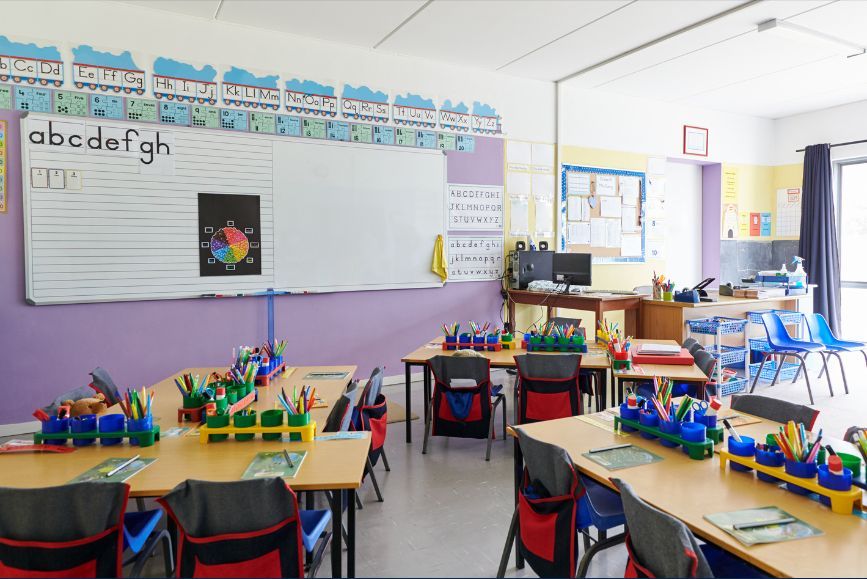Debt vs. Service: The Personal Cost of Teaching
Educators are struggling under the weight of student loan debt. They're burned out, fed up, and ready to move on if teachers don't get the compensation they deserve.

Key Takeaways
- Student loan debt is a significant stressor in the lives of educators. Over 60% of teachers have taken out loans and 40% are still paying them off.
- Teacher morale is at an all time low. Educators have the highest burnout rate of any profession, with 44% feeling burned out always or often.
- More than half of teachers say inadequate compensation is motivating them to quit. 65% of educators cannot live comfortably off their teaching salary and nearly a third have considered resigning before the next school year.
- Funding for continuing education is not enough. Tuition payment or reimbursement does little to help teachers with existing student loan debt. Educators want student loan repayment assistance - a benefit that would help with retention and morale.
Student loan debt plays a significant role in the lives of many educators. Over 60% of public school teachers have taken out loans to pay for their own education and 40% of all teachers are still repaying their loans, some of them decades into their careers.
I talked to educators to see how student loan debt is affecting their lives. They all told me the same thing: they’re not being paid enough to offset the financial strain of maintaining their careers, supplying their classrooms, and making regular student loan payments - and an alarming number of teachers are ready to walk if things don’t improve.
Educators are struggling under student debt
The impact of student loans starts early. Many people I talked to for this series relayed that they took on loans out of necessity without fully understanding what it meant for their future lives.
One teacher wrote, "I felt really uninformed about what my options were and extremely unprepared about what I was doing in general to try to fund school." Even with loans, financial struggles began while they were still working toward their degree. Though in a strenuous combined bachelors-masters program and advised to focus solely on their own education, not working wasn’t an option. "I still had a job because loans only covered the official costs of attending."
As if the job hunt were not stressful enough? the need to start paying back loans became an immediate stressor upon graduation. "Once repayment on the loans went into effect I had to find jobs that would allow me to afford my current expenses as well as my loan payments," said Elizabeth, a former Pre-K instructor.
Even years after graduating, the effects of student loan debt linger. "It takes up a huge part of my budget. My loans make up almost an entire paycheck," one teacher told me. Elizabeth added that she was only making about $800 a paycheck while her loan payment was "at one point, exceeding one thousand dollars a month."

Loan payments are a never-ending stressor
According to the Learning Policy Institute, 2 of every 10 teachers over 62 are still repaying their student loans. That’s a whole career dedicated to educating the nation’s youth while still paying the price for their own education.
"I have always had concerns with paying off my loans," said Elizabeth. "It felt like a hole I would have never been able to dig myself out of. When you look at the estimated repayment date it can be pretty jarring to see a year that people predicted we would have hover cars."
With high interest rates, it takes most borrowers over 20 years to pay off their loans. Though many teachers are eligible for the Public Service Loan Forgiveness (PSLF) program, which forgives the remaining balance after 10 years of regular payments, the program’s 2.3% acceptance rate makes it an unrealistic option for most.
Want to see how PSLF is stacking up in your state?
Visit the National Education Association’s interactive map on The State of Educator Student Debt. For more information on how PSLF is failing public service workers, visit our article, Debt vs. Service: The Dilemma of America’s Essential Workers.
Teaching comes with many hidden costs
When a good friend of mine became an elementary school teacher, I was astonished by how much teaching took over her life. She was consistently working on lesson plans and grading, spending long hours in her classroom well past the end of the school day, and taking home work with her on the weekends. She had to buy almost everything for her classroom aside from the furniture and workbooks. And to top it off, she wasn’t being paid very much, which meant her dream of homeownership was going to have to wait.
"Teaching has always been a highly purposeful but challenging job," explained an article by Gallup, "relatively low wages in comparison to other public sector workers, working with students and navigating family/parent dynamics, and continuously evolving national and state-level policies have made for a difficult job." Add in the need to purchase supplies and make student loan payments, it’s no wonder teacher morale is at an all-time low.
Short-term demands drain teachers
On top of student loan payments, teachers are spending their own money on equipping their classrooms. The average teacher spends $470 on classroom supplies without reimbursement. I have personally known educators who are spending double or even triple that amount, especially during their first year of teaching.
Katie, a middle school teacher, said student loans not only affected her but also her classroom, especially in the early years. “I definitely was more conscious of how much disposable income I had, so I didn't buy fancy decorations for my classroom or oversupply my desk.” For most teachers, making their classrooms an enriching and inviting space means asking for donations from loved ones, requiring families to bring supplies, or paying out of their own pockets.

Many educators also have to take on more responsibilities in addition to an already overwhelming workload. "I feel I need to supplement my income where I can," said one teacher. "Things like covering classes during my off periods, helping with athletics, sponsoring a student club, all things that take up more time and take away from doing my work." Needing to supplement income is especially difficult on newer teachers, who are already navigating a stressful first year.
It’s also very common for educators to take on second or even third jobs. A survey of the class of 2024 found that 32% of graduates plan to do a side job on top of their full-time job, with 45% of them doing it specifically to supplement their income in order to pay debt and other expenses. For most educators, taking on additional work is the norm with 82% of teachers taking on second jobs to supplement insufficient pay.
Student debt delays life goals long-term
Student loan debt affects borrowers throughout their careers, forcing many to push back life goals in order to make ends meet. According to a poll by Gallup, 71% of borrowers have delayed major milestones because of loan payments.
Homeownership was a common topic amongst the educators I spoke to. One teacher said, "I think I've accepted that I likely won't own a home or make any kind of very large purchase for a very, very long time. It is part of my reality that homeownership, expendable income, or serious savings or investments are not a possibility for me." Nearly a third of borrowers delay homeownership due to ongoing student loan debt.
Others I talked to who are already homeowners found student loan debt a barrier when pursuing homeownership. Elizabeth said student loans affected her ability to get a loan for her first home and another public service worker ran into a similar issue, being approved for much less than the median home price where they live.
Katie, who was able to pay off her loans before buying a house in 2020, said, "I was able to make different financial choices because I didn't have a multi-hundred dollar payment pressing on my paycheck every month." For many, the dream of homeownership often has to wait until their student loan debt is paid down or paid off entirely.
The Teacher Shortage is Preventable
A recent poll found that teachers have the highest burnout rate in the nation, with 44% of K-12 educators feeling burned out "always" or "very often."
This is reflected in the number of educators choosing to leave their positions. According to the Wall Street Journal, around 300,000 teachers and other educational staff left the field between February 2020 and May 2022, a 3% drop in the workforce. And the issue is only getting worse. Nearly one third of teachers plan to leave their positions before the next school year.

Though there is little expected growth projected for educators, there is a constant teacher shortage. According to the Bureau of Labor Statistics, over 850,000 teaching positions are vacant at any one time, with most of the vacancies caused by needing to replace workers who willingly choose to leave the field either to transfer to a different occupation or due to retirement.
Compensation is the deciding factor
Compensation is the number one reason educators consider leaving their jobs. A McKinsey study found 69 percent of teachers feel "their total compensation—including base salary and bonuses—does not reflect their qualifications and efforts." 65 percent report not being able to live comfortably off earnings from their teaching positions.
With the average starting salary for teachers at $44k a year and the average pay for all teachers around $64K, it’s unsurprising that more than half of teachers say that lack of compensation is pushing them out the door.
Elizabeth left teaching in 2018, saying of low pay, "it's the only reason I left." Now working in government contracting, she’s making significantly more but at a high personal cost. "I work a job that I don't love because I do not have the flexibility to make less." Like Elizabeth, many passionate teachers leave the profession for financial reasons.
Fair Compensation is the Solution
The way forward is simple - work toward giving teachers what they’re worth. The Learning Policy Institute recommends reducing "student loan-related financial strains" by increasing teachers' net compensation in order to strengthen recruitment and retention. Though raising salaries may take time, there are other ways to unburden teachers financially.
Educators need to know their benefits
Katie, who has been teaching since 2019, said having workshops or info sessions about teacher benefits is the first step. “It would have been nice when we did onboarding for a program of ‘this is what the county offers, this is how you get into it, this is how we can help you.’” By making sure educators are aware of benefits already available to them (and how they can access them), teachers would be able to take advantage of financial support already being offered by their school system.
Funding continuing education is not enough
Funding for continuing education is a common benefit available to educators, though it does little to help teachers with existing student loan debt.

The better of two common educational funding benefits is up-front or direct tuition payment for continuing education or specific certifications. Katie, who’s currently in a masters program for Library Media Studies, told me, “Because it's a critical area, they pay for the tuition. I'm just responsible for fees and my summer classes.”
However, tuition payment is not available for every program or in every school system. "Counties tend to help with things like tuition reimbursement for teachers who go to school as they work, but that’s about it," said one teacher. "You pay the tuition and then they reimburse you once you can provide your grades. But there are some masters programs where you're paying fully out of pocket."
In addition to having to cover costs up-front, tuition reimbursement is not always guaranteed. In under-funded school systems, these funding programs are often lotteries which means many teachers have to take out even more loans in order to stay in compliance with the continuing education requirements of their school systems.
Teachers want student loan assistance
When asked about student loan repayment as a benefit, one teacher told me, "**It would mean the world **but unfortunately it's a constant battle to even see cost of living adjustments in our pay."
They shared with me that having student loan payments played a pivotal role in accepting their current position. "I knew once I graduated I would have to start making payments ASAP so I tried to get a job in a district that would pay the highest starting salary. It was not the district I was leaning towards the most, but once I saw the pay scale I felt my choice was made."
With 86% of employees saying they’d stay with an employer for at least 5 years if that employer contributed to paying off loan debt, offering student loan repayment as a benefit could drastically impact teacher retention rates and allow teachers to work in school systems where they’re most passionate.

Katie, who has already paid off her student loans, said, "I have a lot of privilege in the fact that I didn't have to take out major loans and I was able to repay mine very quickly. I would live a completely different life had I had significant student loans."
Helping to alleviate teacher student loan debt would financially free our teachers, and employee student loan assistance services like Paidly make offering this benefit easy.

Education is not the only public service field struggling with student loans. In the next article, we’ll get into how student debt is affecting our healthcare workers.
Thank you to everyone who generously shared their experiences with me. Quotes were lightly edited for clarity and names of interviewees were included in this article with permission.
Samantha Park
Samantha Park is a writer with a background in public service work. She recently earned a M.S. in Professional Writing from Towson University where she focused on writing for the private and public sectors, and has previously graduated with an A.A. in Psychology from Anne Arundel Community College and a B.A. in Sociology from the University of Maryland College Park. Samantha has worked within and alongside the public sector for the past decade and cares deeply about empowering marginalized youth, expanding access to opportunity through education, and increasing community involvement.
Join our newsletter
Don't miss any more news and subscribe to our newsletter today.
The information provided is of a general nature and an educational resource. It is not intended to provide advice or address the situation of any particular individual or entity. Any recipient shall be responsible for the use to which it puts this document. Paidly shall have no liability for the information provided. While care has been taken to produce this document, Paidly does not warrant, represent or guarantee the completeness, accuracy, adequacy, or fitness with respect to the information contained in this document. The information provided does not reflect new circumstances, or additional regulatory and legal changes. The issues addressed may have legal, financial, and health implications, and we recommend you speak to your legal, financial, and health advisors before acting on any of the information provided.
You may also like

A Meaningful Gift for the Ones Who Matter Most
Gifting financial freedom is more than a gesture - it’s an investment in those you care about. Help your loved ones thrive by supporting their education this holiday season.

The Gift That Keeps On Giving: 529 Year-End Bonuses
Spread your year-end bonus further this season by paying directly toward employees’ 529 educational savings plans.

Why You’ll Want to Put Year-End Bonuses Toward Student Loans
Putting employee year-end bonuses directly toward student loans is the perfect way to strengthen your workforce this holiday season.
